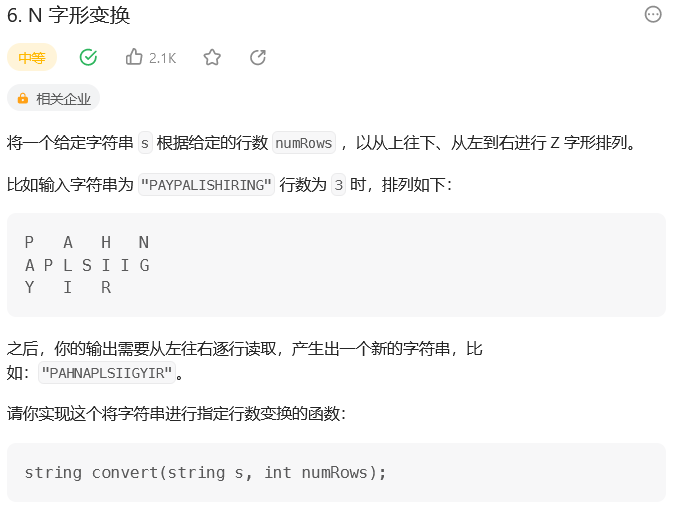6. N 字形变换
题目:


思路:
【1】模拟的方式(采用二维数组,模拟出数据的存放排列,再遍历合成)
【2】按照规律顺序的方式(根据规律逐个放置于新数组中)
代码展示:
//时间80 ms 击败 5.4% //内存53.1 MB 击败 5.1% class Solution { public String convert(String s, int numRows) { int len = s.length(); String[][] tem = new String[numRows][len]; int index = 0; int offset = numRows-1 > 0 ? numRows-1 : 1; // 从左往右遍历 for (int col = 0;col < len;col++){ //从上往下遍历 for (int row = 0;row < numRows;row++){ // 防止溢出 if (index == len) break; // 列偏移 int colDif = col%offset; // 行偏移 int rowDif = row%offset; // 列偏移 = 0这种情况是这一列都要填数据 // 列偏移+行偏移 % 偏移数 = 0 的情况便是之字部分 if (colDif == 0 || (colDif+rowDif)%offset == 0){ tem[row][col] = String.valueOf(s.charAt(index++)); } } // 如果字符填充完了就跳出循环 if (index == len) break; } StringBuffer buf = new StringBuffer(); for (int row = 0;row < numRows;row++){ for (int col = 0;col < len;col++){ if (tem[row][col] != null) buf.append(tem[row][col]); } } return buf.toString(); } } //时间69 ms 击败 5.10% //内存53.5 MB 击败 5.1% //时间复杂度:O(r⋅n),其中 r=numRows,n 为字符串 s 的长度。 //时间主要消耗在矩阵的创建和遍历上,矩阵的行数为 r,列数可以视为 O(n)。 //空间复杂度:O(r⋅n)。矩阵需要 O(r⋅n) 的空间。 class Solution { public String convert(String s, int numRows) { if (numRows<=1) { return s; } int len = s.length(); int offset = numRows - 1; // 当我们在矩阵上填写字符时,会向下填写 numRows 个字符, // 然后向右上继续填写 numRows−2 个字符,最后回到第一行, // 因此 Z 字形变换的周期 t=numRows+numRows−2=2numRows−2, // 每个周期会占用矩阵上的 1+r−2=r−1 列。 // 因此有 n/t 个周期(n为字符串长度,最后一个周期视作完整周期,也就是说如果是有余数的话要+1), // 乘上每个周期的列数,得到矩阵的列数 c=(n/t)⋅(r−1) // [一个周期占用 r-1 列,那么 n/t个周期 占用的列 就是c]。 int t = 2*offset; // 这里之所以 len + t - 1 便是为了考虑java正数相除得整数 // 如 (3 + 3 - 1) / 3 = 1 而 (4 + 3 - 1) / 3 = 2 (相当于向上取整的操作) int colNum = (len + t - 1) / t * offset; String[][] tem = new String[numRows][colNum]; int index = 0; // 从左往右遍历 for (int col = 0;col < colNum;col++){ //从上往下遍历 for (int row = 0;row < numRows;row++){ // 防止溢出 if (index == len) break; // 列偏移 int colDif = col%offset; // 行偏移 int rowDif = row%offset; // 列偏移 = 0这种情况是这一列都要填数据 // 列偏移+行偏移 % 偏移数 = 0 的情况便是之字部分 if (colDif == 0 || (colDif+rowDif)%offset == 0){ tem[row][col] = String.valueOf(s.charAt(index++)); } } // 如果字符填充完了就跳出循环 if (index == len) break; } StringBuffer buf = new StringBuffer(); for (int row = 0;row < numRows;row++){ for (int col = 0;col < colNum;col++){ if (tem[row][col] != null) { buf.append(tem[row][col]); index--; } //如果字符塞完了,就应该停下来 if (index == 0) break; } } return buf.toString(); } } //时间1 ms击败100% //内存42.7 MB击败52.53% class Solution { public String convert(String s, int numRows) { if (numRows<=1) { return s; } char[] chars = s.toCharArray(); int index=0; char[] newChars = new char[chars.length]; for (int level = 0; level < numRows; level++) { // 这里的精髓在于 i= i + 2*(numRows - 1) // 如第一行的表现(可自行画图),这就是能精准的获取下一个字符的位置 for (int i = level; i<chars.length; i= i + 2*(numRows - 1)) { newChars[index++] = chars[i]; // 因为第一行和最后一行是没有之字的部分的。故跳过 if (level==0 || level == numRows-1) { continue; } // 之字部分的填充 int deep = numRows - level; // 要判断不溢出 if (i + 2*(deep - 1) < chars.length) { newChars[index++] = chars[i + 2*(deep - 1)]; } } } return new String(newChars); } }



 浙公网安备 33010602011771号
浙公网安备 33010602011771号